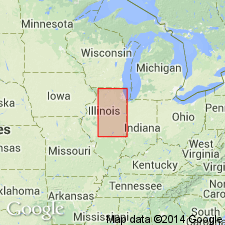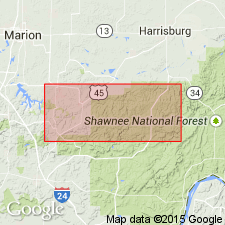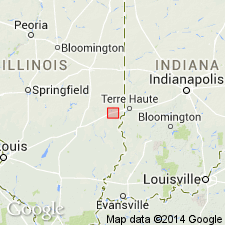
- Usage in publication:
-
- Peyton Colluvium
- Modifications:
-
- Named
- Dominant lithology:
-
- Silt
- AAPG geologic province:
-
- Illinois basin
Summary:
The Peyton Colluvium, here named for Peyton Creek in Peoria Co., IL, is classified as a formation. It includes widely distributed but narrow belts of poorly sorted debris that accumulated at the base of steep slopes by creep and slopewash. Included in the Peyton are the numerous small alluvial fans and cones that occur at nearly every gully and grade into slopewash deposits. Material is dominantly a pebbly silt, but its composition depends on the material in the bluffs above. Along loess-mantled bluffs it appears to grade upward into loess by decrease in the abundance of pebbles. At its lower margin, the colluvium grades or interfingers into the stream or river alluvium, but the Peyton is separated from the Cahokia Alluvium by vertical cutoff.
Source: GNU records (USGS DDS-6; Reston GNULEX).

- Usage in publication:
-
- Peyton Formation
- Modifications:
-
- Revised
- Overview
- AAPG geologic province:
-
- Illinois basin
Summary:
Peyton Formation includes all sediment deposited by mass wasting and colluvium at the base of slopes that has accumulated from the end of the Wisconsinan to the present. Consists of reworked loess, residuum, and clasts of bedrock. Generally thin, yellowish brown to brown and leached of carbonate minerals. Grades into alluvium that is stratified and better sorted. Arbitrary vertical line separates fluvial deposits of the Cahokia Formation from the colluvial deposits of the Peyton.
Source: GNU records (USGS DDS-6; Reston GNULEX).

- Usage in publication:
-
- Peyton Colluvium
- Modifications:
-
- Overview
- AAPG geologic province:
-
- Illinois basin
Summary:
Peyton Colluvium in the study area occurs primarily at the base of slopes between the uplands and valleys of the North Fork Embarras River, Bluegrass Creek, Kettering Branch, and their tributaries adjacent to and on the Martinsville site. The lithology of the Peyton is similar to the lithology of the sediment from which the colluvium is derived. The local thickness of the unit changes significantly as it is removed by stream erosion at the base of slopes. Age has not been determined.
Source: GNU records (USGS DDS-6; Reston GNULEX).
For more information, please contact Nancy Stamm, Geologic Names Committee Secretary.
Asterisk (*) indicates published by U.S. Geological Survey authors.
"No current usage" (†) implies that a name has been abandoned or has fallen into disuse. Former usage and, if known, replacement name given in parentheses ( ).
Slash (/) indicates name conflicts with nomenclatural guidelines (CSN, 1933; ACSN, 1961, 1970; NACSN, 1983, 2005, 2021). May be explained within brackets ([ ]).

